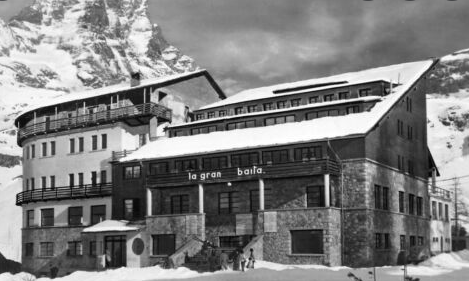In April 1936 the legendary transportation of the cables took place: three massive reels, weighing 50 tonnes, reached Chambave by train and were then loaded on three lorries, proceeding at a slow pace while the workmen held the cables between vehicles on their shoulders. Once completed the cabins could carry 35 people, covering the distance in 7 minutes, with a maximum capacity of about
500 people per hour. During spring 1936 the private road connecting the square in Breuil to the departing station of Museroche, and the arrival station in Plan maison were built. The cablecar
opened on August the 2nd 1936 and introduces a huge tourist development: summer 1936 saw an average daily flow of 300-600 cars. The real tourist development of the Breuil basin had begun, and the need for services was imperative: postal and telegraphic services were facilitated, and soon after a telephone connection as well. During the board of directors of July the 23rd 1936, Lora
Totino suggested that the partners take a further step: now that most of the technical issues had been resolved it’s time to make the investments fruitful, for the tourism infrastructure, adapting the upper part of Museroche’s station as hotel, restaurant and bar, and to build the Ristorante Belvedere at the lift station in Plan Maison, an area of incomparable beauty and the perfect destination for
hikers. Here then the original station changes to being a receptive complex, making it significantly enhanced. The functional spaces are incorporated in a structure characterised by a big gabled roof. On the same line of the roof’s ridge, a low and long structure is developed, which is rounded towards North-West, including a basement and two floors above ground, everything covered by a big terrace. On the 1st of June 1937 it was opened, named “Grande Albergo del Breuil – Gran Baita”. Otto Bermann took control of it, with his experience as a director of the nearby Grande Albergo Cervinia. After two weeks Bermann asked for a development concession to further enhance the structure and on August the 24th the approval to raise the Grande Albergo del Breuil of two storeys was granted. An extra floor was built including an attic made of wood with a single pitched roof, surrounded by a small terrace. On July the 8th 1939 a fire destroyed the attic of the Gran
Baita, damaging the underlying floor. After the event two identical floors were rebuilt. The hotel could then accommodate 120 guests. In 1940 the law to “remove signs in English or French” was
made, therefore “Grande Albergo del Breuil” is a replaced with an ever-so-Italian “La Gran Baita”, the great alpine hut. Only in a later stage French will return with a sign above the entrance of the cableway with a quote taken from a restaurant on the shore of Lac Leman, modified with regards to the mountains and attributed to Lord Byron: “Heureux celui qui sur ces monts put longtemps se reposer. Heureux celui qui les revoit s’il a du les quitter”. “Happy is he who on these mountains could rest for a long time. Happy is the one who sees them again if he had to leave them “
Italy went into war and life gets tougher, as the Nation puts everyone in a state of privation and struggle. However, in Cervinia life stays cheerful. On March the 16th 1944, the prefect of the
Province of Aosta commands the Gran Baita to be shut for an indefinite period, for the “continuous failure to comply to regulations regarding goods rationing, dancing, alcohol and spirits sales and non-observing pricing policies”, as well as “displays of immorality”. Responsibility falls on the manager, yet the guilt is of ten people ruling for two years over the hotel, covered by their questionable war earnings. The Società Cervino canceled the contract stipulated with the manager because of his guilt and commits the hotel to Perino on the 31st of March 1944. Soon all the best hotels of the area, Gran Baita, Cervinia and Monte Cervino were shut and all the furnishings, food supplies, wines and spirits were confiscated. When armistice came everything went back into business, cable cars and hotels. The big terrace of the Gran Baita needed expensive repairs, therefore in 1948 the decision was taken to rebuild a pitched roof, further raising the structure by another storey, and to install a lift in 1949. After more restoration was conducted in 1953, the management passes to the Borghigiani family. In 1969 the Gran Baita was closed to the public as a hotel and used as a lodging and competition office, especially for the Chilometro Lanciato (1970-72). On April the 7th, 1973 a new fire, despite not hurting anyone, destroyed the building, taking away a strong symbol of Cervinia. It has been untouched since then but finally there has been interest to buy the building and hopefully restore it.

